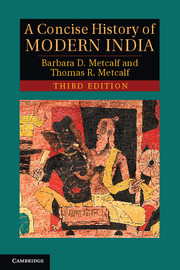Book contents
- Frontmatter
- Contents
- Illustrations
- Preface to the third edition
- Preface to the first edition
- Glossary
- Chronology
- 1 Sultans, Mughals, and Pre-Colonial Indian Society
- 2 Mughal Twilight: The Emergence of Regional States and the East India Company
- 3 The East India Company Raj, 1772–1850
- 4 Revolt, the Modern State, and Colonized Subjects, 1848–1885
- 5 Civil Society, Colonial Constraints, 1885–1919
- 6 The Crisis of the Colonial Order, 1919–1939
- 7 The 1940s: Triumph and Tragedy
- 8 Congress Raj: Democracy and Development, 1950–1989
- 9 Democratic India at the Turn of the Millennium: Prosperity, Poverty, Power
- Biographical notes
- Bibliographic essay
- Index
8 - Congress Raj: Democracy and Development, 1950–1989
Published online by Cambridge University Press: 05 November 2012
- Frontmatter
- Contents
- Illustrations
- Preface to the third edition
- Preface to the first edition
- Glossary
- Chronology
- 1 Sultans, Mughals, and Pre-Colonial Indian Society
- 2 Mughal Twilight: The Emergence of Regional States and the East India Company
- 3 The East India Company Raj, 1772–1850
- 4 Revolt, the Modern State, and Colonized Subjects, 1848–1885
- 5 Civil Society, Colonial Constraints, 1885–1919
- 6 The Crisis of the Colonial Order, 1919–1939
- 7 The 1940s: Triumph and Tragedy
- 8 Congress Raj: Democracy and Development, 1950–1989
- 9 Democratic India at the Turn of the Millennium: Prosperity, Poverty, Power
- Biographical notes
- Bibliographic essay
- Index
Summary
Hammered out during intense debates in a constituent assembly which sat from 1947 to 1949, India's constitution established a set of principles and institutions that have governed the country's political life up to the present. Under it, as Nehru sought to create a ‘modern’ free India, the country decisively repudiated much of its colonial heritage. Although remaining a member of the Commonwealth, India was proclaimed a republic, thus ending its allegiance to the British Crown, when the constitution was inaugurated. That date, 26 January, known as Republic Day, with a massive parade in New Delhi, has remained a major focus for India's celebration of its nationhood. Rejecting the imperial vice-regal style of government associated with the Raj, the new India nevertheless sought inspiration in domestic British political practice. The constitution put in place a Westminster style of government, with a parliament comprising two houses, and a prime minister selected by the majority party in the lower house, called the Lok Sabha or House of the People. Nehru took up the position of prime minister, while the president, installed in the old vice-regal palace, acted, like the sovereign in Britain, as titular head of state. The old colonial separate electorates, with their divisive tendencies, were in similar fashion abolished in favour of single member constituencies, modelled on those in Britain itself, open to all.
Elements of the old colonial style of governance nevertheless persisted under the new order. Some 200 articles of the Government of India Act of 1935, for instance, were incorporated into the new constitution. The federal structure, in which power was shared between the centre and the former provinces, now become states, remained intact. So too, significantly, did the provision of the 1935 Act which awarded the provincial governor, and president, imperial-style power to set aside elected ministries in times of emergency. These powers were often employed in independent India to intimidate recalcitrant state governments, and, in one exceptional instance, to facilitate a period of authoritarian ‘emergency’ rule throughout the country. In addition, the administrative structure of the Indian Civil Service, renamed the Indian Administrative Service, remained in place. This ‘steel frame’, its British members replaced by Indians trained in the same spirit of impartial governance, was seen, in the tumultuous years after independence, as a necessary bulwark of stability for the new government.
- Type
- Chapter
- Information
- A Concise History of Modern India , pp. 231 - 264Publisher: Cambridge University PressPrint publication year: 2012



